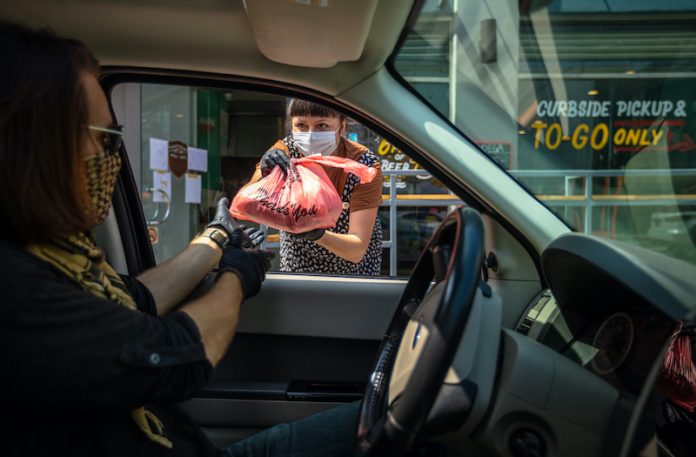
Deloitte has released the results of its recent survey, “The Restaurant of the Future: A Vision Evolves.” Findings of the survey include that almost two-thirds (64 percent) of consumers do not plan to return to their pre-pandemic habits of dining in restaurants within the next six months. Convenient off-premises dining has emerged as a permanent fixture in the restaurant experience, with 61 percent of consumers ordering takeout or delivery at least once per week, up from 29 percent one year ago and 18 percent prior to the pandemic.
Demand for frictionless digital experiences continues to be at the top of the menu. More than half (57 percent) of consumers ordering takeout or delivery prefer to use a digital app; nearly two-thirds (67 percent) of on-premise diners prefer to order their food digitally. One-third of consumers say enhanced cleanliness and safety protocols are important in returning to on-premises dining sooner and more frequently.
The restaurant industry has been on a roller coaster for nearly two years, as changes fueled by COVID-19 continue to unfold at a rapid pace. Deloitte’s new report examines how consumer demand for convenience, digital experiences, and safety are permanently influencing restaurants’ business models. The report is based on a survey of 1,000 U.S. adults fielded in September 2021 who had ordered from a restaurant within the last three months.
While restaurants used to be synonymous with a traditional dining room setting, a growing preference for the convenience of off-premises dining is driving consumer demand for restaurant-style quality and variety. In fact, 64 percent of consumers don’t plan to return to their pre-pandemic habits of dining in restaurants within the next six months. Additional findings include:
- The incidence of takeout and delivery orders is surging even as dining rooms have reopened with 61 percent of consumers ordering takeout or delivery from restaurants at least once per week, up from 29 percent one year ago and 18 percent prior to the pandemic.
- Quality is an important ingredient in all orders as three in five customers expect the same quality and freshness in delivery and takeout as they do in the dining room.
- Consumers order from quick-service restaurants (QSRs) most often at 62.6 percent, followed by fast-casual restaurants (52 percent), and casual dining establishments (40.5%). Spending at QSRs also is up more than 100 percent year-over-year.
- Whether dining on-premises or off, nearly three-quarters of respondents (68 percent) don’t want to wait more than 30 minutes for their food (unchanged from 2020), demonstrating the ongoing preference for speed of service.
- In addition, an overwhelming 79 percent of consumers say they are likely to order from ghost kitchens, a trend which is 20 percent greater than a year ago and 32 percent higher than two years ago.
- Amid numerous options for restaurant ordering, the drive-through is the most preferred method, with 37 percent of respondents ranking it as a first choice.
“It’s been said that the only constant is change, which holds true for the restaurant industry today. The pandemic has accelerated the progress of the restaurant of the future, calling for fundamental shifts in business models to meet new demands. Now, amid continued pressures in areas like supply chain, safety-related costs, and labor availability costs, restaurants should work strategically to build loyalty among on-premises and off-premises diners. Those that can quickly adapt and meet diners’ evolving demands for convenience, frictionless digital experiences, and safety can be poised to not only survive but thrive,” says Jean Chick, principal, Deloitte Consulting LLP, and U.S. restaurant and foodservice leader.
Driven by the demand for contactless delivery, the pandemic quickly accelerated digitization in the restaurant industry. Now, restaurants are leveraging technology to reshape both off-premises and on-premises dining experiences with enhancements to not only delivery, but the ordering process, food preparation and payment options, and consumers are eating it up. More information includes:
- More than half of consumers (57 percent) use a digital app to order restaurant food for off-premises dining, up from 54 percent in 2020. However, digital ordering in-restaurant is growing at an even faster pace: nearly two-thirds of consumers (64 percent) prefer to order their food digitally (versus 53 percent in 2020), even if it means less interaction with waitstaff.
- When considering the channel from which to order their food, 40 percent of consumers prefer to use a restaurant’s own branded website or app compared to 11 percent who prefer a third-party food ordering and delivery platform.
- Advanced technologies are gaining traction as 4 out of 5 people (81 percent) would order from an automated voice system built into the drive-through lane. Further, the number of consumers willing to receive food delivered by a drone or driverless car is up by 10 percent year-over-year.
Technology is permeating kitchens to improve order accuracy, efficiency, and cost control. More than half of the survey respondents (54 percent) would order from a partially or fully automated kitchen. - Food payments are also evolving, with one-quarter of customers preferring a digital or contactless payment method to a physical one.
- Loyalty programs are another area in which technology plays a role: The average consumer participates in two restaurant loyalty programs, and 79 PERCENT of survey respondents said their participation impacts where they dine.
Restaurants have always had a focus on safety; however, the long-term effects of the pandemic are continuing to impact consumers’ feelings about frequenting restaurants and the food they order. According to the study, consumers must visibly see the procedures taken to protect the preparation and transport of their food to instill confidence in the dining experience. The survey concludes:
- One-third (33 percent) of all consumers say enhanced cleanliness and safety protocols are important to returning to on-premises dining sooner and dining out more frequently. This is particularly true for Boomers (32.3 percent), Gen X (23 percent), and Millennials (25.2 percent), while safety is less of a priority for Gen Z (4.9 percent).
- More than half (55 percent) of respondents are willing to pay between 10 percent and 50 percent more to know about the safety and cleanliness that surround the preparation and transport of their food.
Almost half (45 percent) of consumers are unlikely to return to a restaurant that had a food safety incident.











